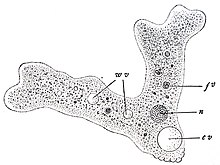变形虫科
变形虫目的一科原生生物
变形虫科(学名:Amoebidae),又称真正变形虫科、阿米巴科,是变形虫界叶足亚门的一个科,最早由克里斯汀·戈特弗里德·埃伦伯格于1838年发表描述。本科的类群会形成接近圆柱状、顶端透明的伪足以司摄食,通常具有数个伪足。细胞中可能具有单一细胞核,也可能具有多个细胞核。核仁常分为数个片段。细胞质中具有许多结晶[1]。
| 变形虫科 | |
|---|---|

| |
| 大变形虫 | |
| 科学分类 | |
| 门: | 变形虫门 Amoebozoa |
| 纲: | 根足纲 Rhizopodea |
| 目: | 变形目 Amoebida |
| 科: | 变形虫科 Amoebidae Ehrenberg, 1838 |
| 属 | |
| |
分类 编辑
变形虫科过去曾被归入变形虫目(Amoebida)[2][3][4]。1987年,本科被归入叶足纲裸阿米巴亚纲的真变形目(Euamoebida),同目还有甲变科(Thecamoebidae)、哈氏科(Hartmannellidae)、蒲变科(Vannellidae)、拟变形科(Paramoebidae)与杆变科(Vexilliferidae)等科[1]。2001年,有学者指出变形虫科、哈氏科与胶丝目(Leptomyxida)为裸阿米巴亚纲的核心演化支[5],后来也有分子种系发生学的研究结果支持此观点,且发现有壳管状根足目(Arcellinida)亦属于此演化支[6] 。2005年,一篇研究以核糖体DNA序列分析叶足亚门各类群的亲缘关系,结果将变形菌科与哈氏科归入新设立的Tubulinea纲Tubulinida目。胶丝目与有壳管状根足目亦被归入Tubulinea纲中[7]。
2009年的一篇研究显示本科的类群中,卓变形虫属可能不是单系群,该研究做出的演化树显示C. nobile比卡罗来纳卓变虫(C. carolinense)和变形虫属的物种还早分支[8]。
| |||||||||||||||||||||||||
属 编辑
- 变形虫属 Amoeba
- 卓变形虫属 Chaos
- Deuteramoeba
- Hydramoeba
- 后卓变虫属 Metachaos
- Metamoeba
- Parachaos
- 多卓变虫属 Polychaos
- Stygamoeba
- 毛变形虫属 Trichamoeba
已灭绝类群 编辑
- Triassamoeba:于1993年由Poinar发表,出土于德国南部三叠纪的琥珀中,学名为Triassamoeba alpha[9]。
参考文献 编辑
- ^ 1.0 1.1 Page, Frederick C. The Classification of ‘Naked’ Amoebae (Phylum Rhizopoda). Archiv für Protistenkunde. 1987, 133 (3-4): 199–217. ISSN 0003-9365. doi:10.1016/S0003-9365(87)80053-2.
- ^ Thomas C. Cheng. General Parasitology. Elsevier Science. 2 December 2012: 154. ISBN 978-0-323-14010-2.
- ^ Francis Polkinghorne Pascoe. Zoological Classification: A Handy Book of Reference with Tables of the Subkingdoms, Classes, Orders, Etc., of the Animal Kingdom, Their Characters and Lists of the Families and Principal Genera. J. Van Voorst. 1880: 8.
- ^ Baij Nath Singh. Pathogenic and Non-Pathogenic Amoebae. Macmillan International Higher Education. 18 June 1975: 35. ISBN 978-1-349-02620-3.
- ^ Bolivar, Ignacio; Fahrni, José F.; Smirnov, Alexei; Pawlowski, Jan. SSU rRNA-based Phylogenetic Position of the Genera Amoeba and Chaos (Lobosea, Gymnamoebia): The Origin of Gymnamoebae Revisited. Molecular Biology and Evolution. 2001, 18 (12): 2306–2314. ISSN 1537-1719. doi:10.1093/oxfordjournals.molbev.a003777.
- ^ Nikolaev, S. The Testate Lobose Amoebae (Order Arcellinida Kent, 1880) Finally Find their Home within Amoebozoa. Protist. 2005, 156 (2): 191–202. ISSN 1434-4610. doi:10.1016/j.protis.2005.03.002.
- ^ Smirnov, A. Molecular Phylogeny and Classification of the Lobose Amoebae. Protist. 2005, 156 (2): 129–142. ISSN 1434-4610. doi:10.1016/j.protis.2005.06.002.
- ^ Pawlowski, J.; Burki, F. Untangling the phylogeny of amoeboid protists. Journal of Eukaryotic Microbiology. Jan–Feb 2009, 56 (1): 16–26. PMID 19335771. doi:10.1111/j.1550-7408.2008.00379.x.
- ^ Poinar, G. O.; Waggoner, B. M.; Bauer, U. -C. Description and paleoecology of a Triassic amoeba. Naturwissenschaften. 1993, 80 (12): 566–568. ISSN 0028-1042. doi:10.1007/BF01149273.